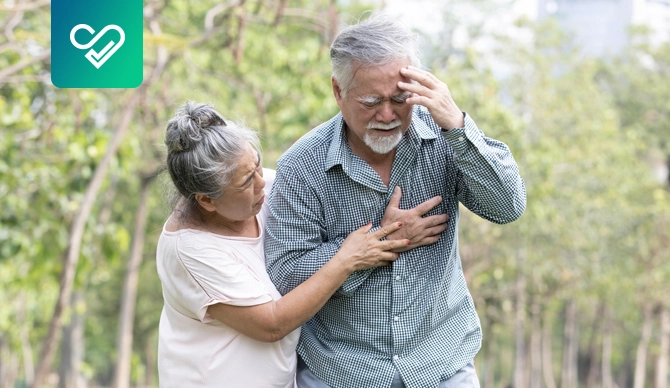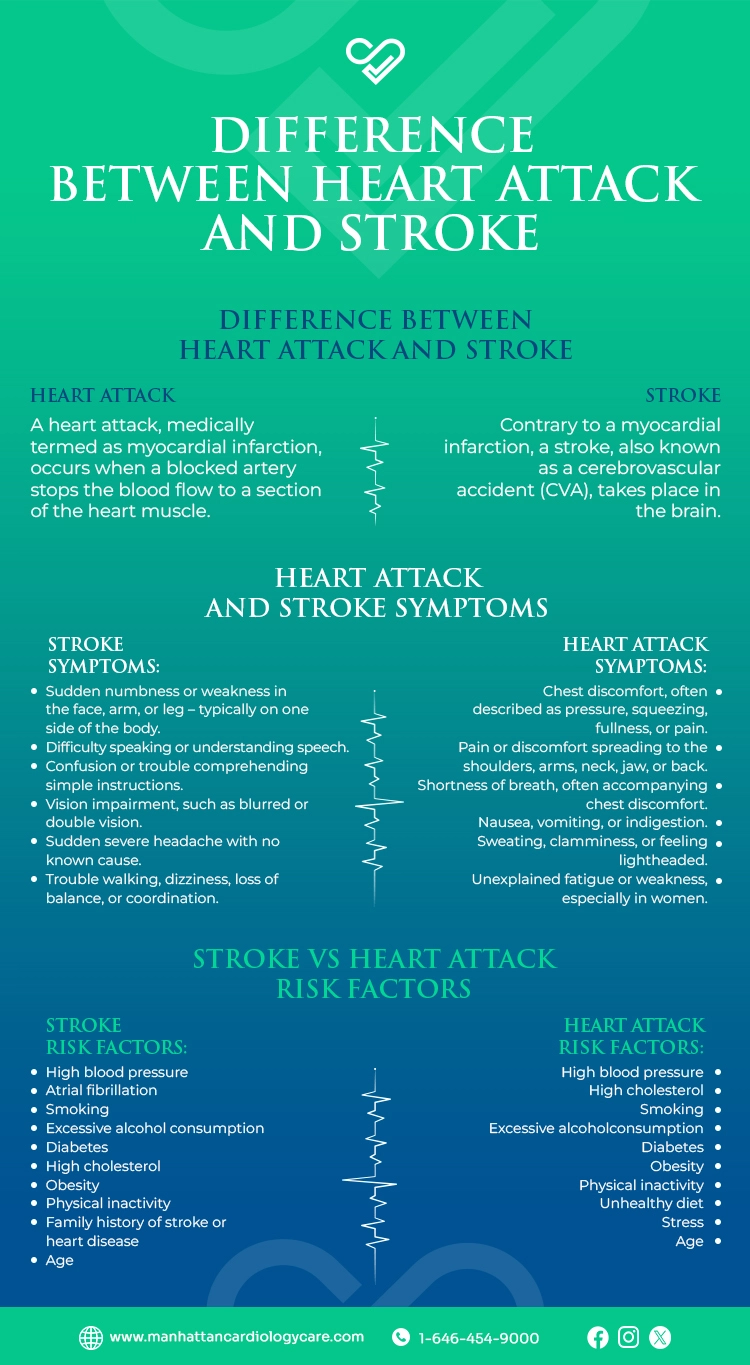Have you ever experienced a sudden sensation that runs through your body, leaving you confused, and questioning if it’s a heart attack or a stroke?
Understanding these cardiovascular emergencies is not only important for immediate action, but also for long-term preventive care.
In today’s blog, we will understand the complexities and difference between heart attack and stroke – exploring all the vital information that could possibly save lives.
Table of contents
Heart Attack
A heart attack, medically termed as myocardial infarction, occurs when a blocked artery stops the blood flow to a section of the heart muscle.
This stopage is often the result of plaque buildup in the coronary arteries, which leads to a sudden restriction of oxygen and nutrient supply to the affected area.
Without instant intervention, irreversible damage to the heart muscle can occur, which could result in severe complications or even death.
Stroke
Contrary to a myocardial infarction, a stroke, also known as a cerebrovascular accident (CVA), takes place in the brain.
A stroke occurs mainly due to a ruptured blood vessel that is supplying oxygen and nutrients to the brain, or when that vessel is obstructed by a clot.
As a consequence, the deprived brain cells begin to die within minutes, giving rise to various neurological deficits depending on the region affected.
Difference Between Heart Attack And Stroke
While both heart attack and stroke involve the interruption of blood flow, their underlying mechanisms and target organs differ significantly.
A myocardial infarction affects the heart muscle due to compromised blood supply to the coronary arteries, whereas a stroke disturbs the brain function due to interrupted cerebral blood flow.
Additionally, the symptoms, risk factors, and preventive strategies diverge between these two cardiovascular diseases.
Heart Attack And Stroke Symptoms
Identifying the heart attack and stroke symptoms instantly and seeking immediate medical attention is immensely important to get treatment in a timely manner.
Stroke Symptoms:
- Sudden numbness or weakness in the face, arm, or leg – typically on one side of the body.
- Difficulty speaking or understanding speech.
- Confusion or trouble comprehending simple instructions.
- Vision impairment, such as blurred or double vision.
- Sudden severe headache with no known cause.
- Trouble walking, dizziness, loss of balance, or coordination.
Heart Attack Symptoms:
- Chest discomfort, often described as pressure, squeezing, fullness, or pain.
- Pain or discomfort spreading to the shoulders, arms, neck, jaw, or back.
- Shortness of breath, often accompanying chest discomfort.
- Nausea, vomiting, or indigestion.
- Sweating, clamminess, or feeling lightheaded.
- Unexplained fatigue or weakness, especially in women.
Stroke vs Heart Attack Risk Factors
It is essential to manage the risk factors associated to heart attack and stroke to prevent either from occurring.
Stroke Risk Factors:
- High blood pressure
- Atrial fibrillation
- Smoking
- Diabetes
- High cholesterol
- Obesity
- Physical inactivity
- Excessive alcohol consumption
- Age
- Family history of stroke or heart disease
Heart Attack Risk Factors:
- High blood pressure
- High cholesterol
- Smoking
- Diabetes
- Obesity
- Physical inactivity
- Unhealthy diet
- Excessive alcohol consumption
- Stress
- Age
Stroke vs Heart Attack Prevention
Implementing these measures listed below, help reduce the risk of heart attack and stroke, promoting overall cardiovascular health.
Stroke Prevention:
- Control high blood pressure.
- Manage atrial fibrillation.
- Quit smoking.
- Manage diabetes.
- Maintain healthy cholesterol levels.
- Maintain a healthy weight.
- Engage in regular physical activity.
- Limit alcohol consumption.
- Eat a healthy diet.
- Manage stress.
Heart Attack Prevention:
- Control high blood pressure.
- Maintain healthy cholesterol levels.
- Quit smoking.
- Manage diabetes.
- Maintain a healthy weight.
- Engage in regular physical activity.
- Follow a heart-healthy diet.
- Limit alcohol consumption.
- Manage stress.
- Take prescribed medications.
When to See a Doctor?
Seeking immediate medical attention upon experiencing heart attack or stroke symptoms is non-negotiable.
Time is of the essence, as timely intervention can save heart muscle or brain tissue, potentially averting irreversible damage and complications.
Remember, swift action could be the difference between life and death.
– Disclaimer –
This blog is for informational & educational purposes only, and does not intend to substitute any professional medical advice or consultation. For any health related concerns, please consult with your physician, or call 911.


